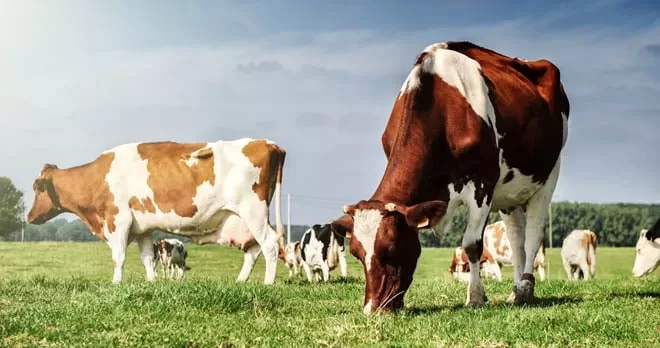By Noah Litherland, Extension Dairy Scientist, on the topic of dry cow management.
I have received a few calls this fall from producers concerned with low colostrum production from fresh cows. Complaints of insufficient colostrum production appear to re-surface in the late fall every year. We know that providing adequate amounts of quality colostrum to dairy calves within the first hours after birth will improve calf health, growth, and lifetime performance. We also know that some cows produce too much colostrum, which can result in a dilution of nutrients, antibodies, and other components in colostrum (colostral IgG concentration is often negatively correlated with colostrum production). Prichett et al. (1991) determined that cows producing less than 18.7 pounds of colostrum at first milking were more likely to produce high-quality colostrum than cows producing higher quantities of first milking colostrum.
|
|
What cow factors might lead to low or insufficient colostrum production? Factors regulating colostrum production have not been intensively researched. Frequent nutrition recommendations to boost colostrum production have been: 1) add a by-pass protein source (to increase rumen-undegradable protein); 2) increase energy intake (up to NRC, 2001 requirements); 3) improve dry matter intake. Cow to cow variation of colostrum production is high and, to the author’s knowledge, research focusing on dietary treatments aimed at improving colostrum volume has not yet been conducted. Colostrogenesis (colostrum production) begins as early as 4 to 5 weeks before calving; therefore, dry cow management and nutrition likely play a substantial role in determining not only colostrum quality but colostrum volume as well.
Colostrum production appears to be cow dependent, but is likely affected by a number of factors. This fall in the University of Minnesota’s St. Paul herd, we are measuring colostrum production in a modest number (60) of multiparous cows fed a balanced diet to meet nutrient requirements during the dry period (NRC, 2001). Although animal numbers are inadequate to draw solid conclusions, the average first milking colostrum production so far is 16.7 pounds with a low of 5.4 and a high of 31.2 pounds. If we assume that an average large breed dairy calf needs approximately 10 to 12 pounds of good quality colostrum in the first 24 hours of life, then almost 20% of cows in this modest data set would not have produced an adequate volume of colostrum to feed their calf. Reserve frozen colostrum would need to be used to provide adequate colostrum volume to newborn calves from mothers with insufficient colostrum production.
Table 1 contains a review of potential factors that may constrain colostrum production. Some are monitors for identifying whether or not these constraints are present on your farm and some are potential management solutions. References for peer reviewed published literature addressing these factors are also provided.
| Table 1. Management factors associated with low colostrum volume. | |||
| Potential factor constraining colostrum production | Monitor | Potential management solution | Reference(s) |
| Colostrum leaking (delay in time to first milking after parturition) | Record calving time and time at first milking. Calculate the lag before first milking after calving. | Develop calf birth chart: Calf ID, Birth time, Body weight, Amount of colostrum fed and by whom, Calving ease score. | Moore et al., 2005. Kruse et al., 1970. |
| Excessively short (<21 day dry period) or calving prematurely | Calculate expected vs. actual dry period length.
Calculate expected vs. actual calving date. |
Track common factors associated with early calving (twins, first calf heifers, stress, incorrect breeding date). | Grusenmeyer et al., 2006. Rastani et al., 2005. Dixon et al., 1961. |
| Low dry matter intake | Measure dry matter intake in the close-up pen weekly.
Evaluate yeast and mold count in ingredients and in the TMR. |
Provide adequate bunk space.
Reduce social stress and pen moves. Avoid over-feeding energy. Avoid excess body condition. Discard moldy feed. |
Tygesen et al., 2008. Finks-Gremmels, 2008. |
| Low water intake | Monitor cow drinking behavior and response to new water sources. | Clean out water supply weekly and check for adequate flow.
Dry cows need 8 to 12 gallons of water per day. |
NRC, 2001. |
| Udder edema | Udder edema scoring (track number of days with high scores). | Moderate potassium intake.
Reduce salt intake. Avoid over-feeding energy. Provide exercise opportunities. |
Melendez et al., 2006. Dentine et al., 1984. |
| Mastitis | Presence of flakes or clots in colostrum.
California mastitis test results (can evaluate the relative difference between quarters). |
Evaluate dry-off procedure.
Monitor udder involution and udder health at dry off and at calving. Evaluate subclinical mastitis cases in late lactation. |
Maunsell et al., 1998. |
| Heat stress | Heat stress behavior.
Dry matter intake. Temperature humidity index in dry cow pen. |
Implement heat-abatement strategies for dry cows routinely used for lactating cows. | Nardone et al., 1997. |
The Milk House thanks Noah Litherland and the Dairy Connection writers from the University of Minnesota Dairy Extension.


